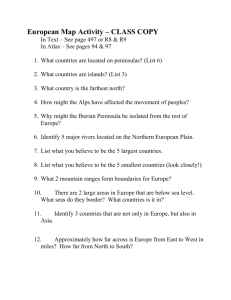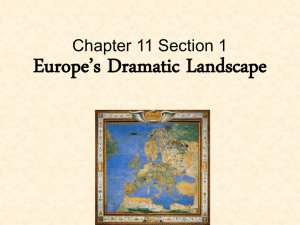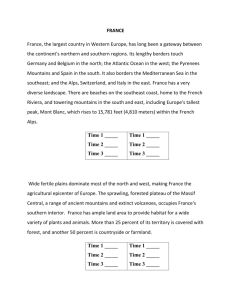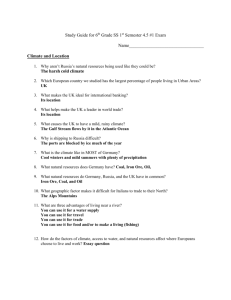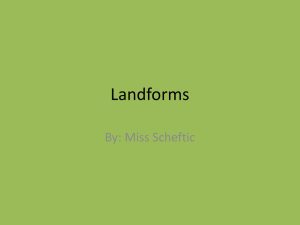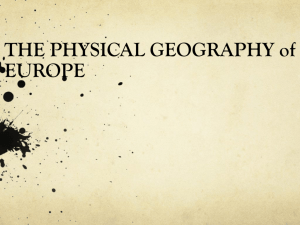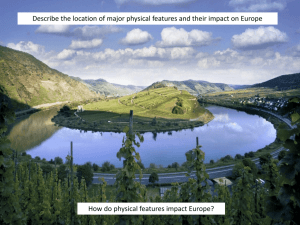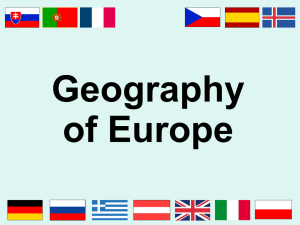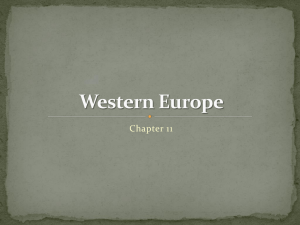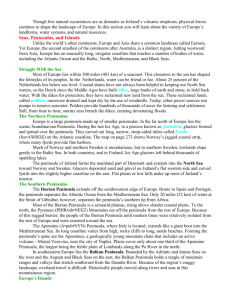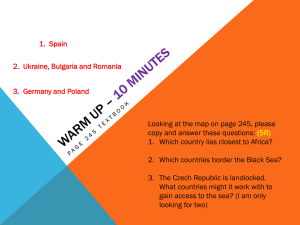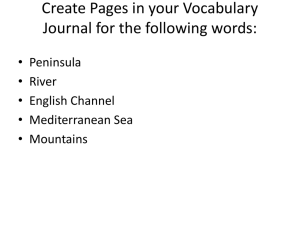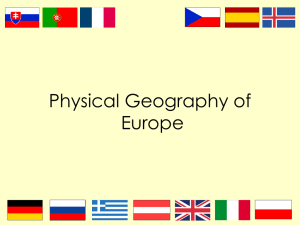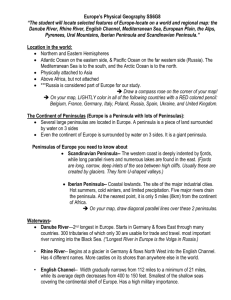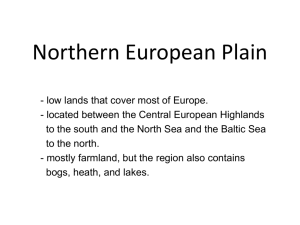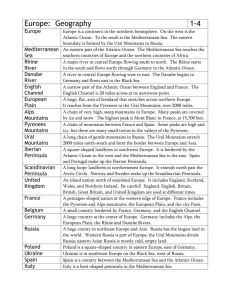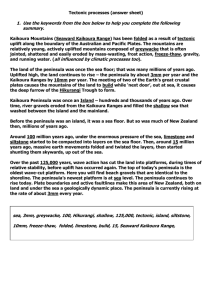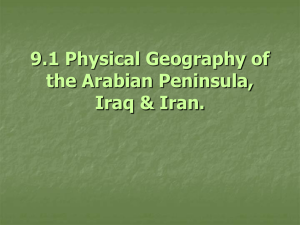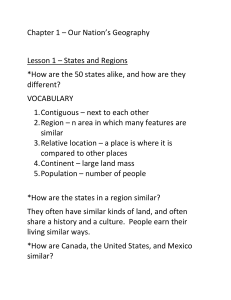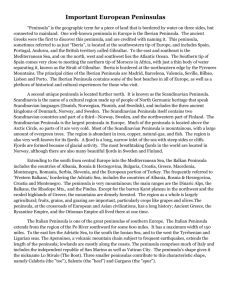Russia and Northern Eurasia Study Guide
advertisement
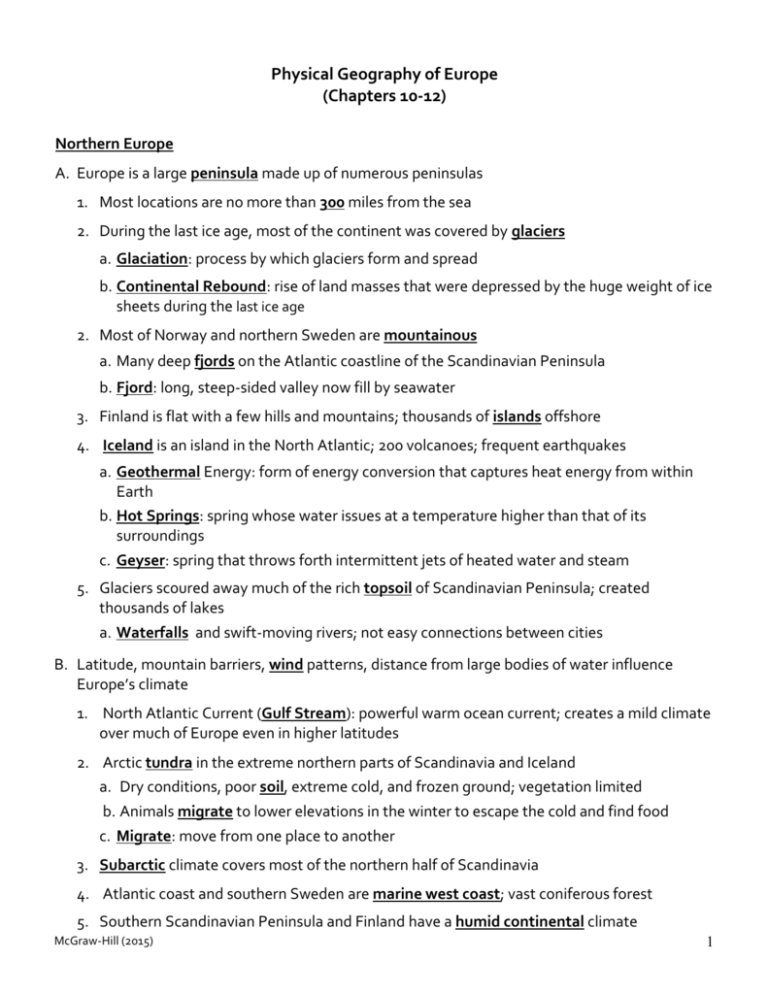
Physical Geography of Europe (Chapters 10-12) Northern Europe A. Europe is a large peninsula made up of numerous peninsulas 1. Most locations are no more than 300 miles from the sea 2. During the last ice age, most of the continent was covered by glaciers a. Glaciation: process by which glaciers form and spread b. Continental Rebound: rise of land masses that were depressed by the huge weight of ice sheets during the last ice age 2. Most of Norway and northern Sweden are mountainous a. Many deep fjords on the Atlantic coastline of the Scandinavian Peninsula b. Fjord: long, steep-sided valley now fill by seawater 3. Finland is flat with a few hills and mountains; thousands of islands offshore 4. Iceland is an island in the North Atlantic; 200 volcanoes; frequent earthquakes a. Geothermal Energy: form of energy conversion that captures heat energy from within Earth b. Hot Springs: spring whose water issues at a temperature higher than that of its surroundings c. Geyser: spring that throws forth intermittent jets of heated water and steam 5. Glaciers scoured away much of the rich topsoil of Scandinavian Peninsula; created thousands of lakes a. Waterfalls and swift-moving rivers; not easy connections between cities B. Latitude, mountain barriers, wind patterns, distance from large bodies of water influence Europe’s climate 1. North Atlantic Current (Gulf Stream): powerful warm ocean current; creates a mild climate over much of Europe even in higher latitudes 2. Arctic tundra in the extreme northern parts of Scandinavia and Iceland a. Dry conditions, poor soil, extreme cold, and frozen ground; vegetation limited b. Animals migrate to lower elevations in the winter to escape the cold and find food c. Migrate: move from one place to another 3. Subarctic climate covers most of the northern half of Scandinavia 4. Atlantic coast and southern Sweden are marine west coast; vast coniferous forest 5. Southern Scandinavian Peninsula and Finland have a humid continental climate McGraw-Hill (2015) 1 C. Finland has large deposits of peat: vegetable matter found in swamps; dug up, chopped into blocks, and dried so it can be burned 1. Minerals include iron ore, nickel, zinc, and copper 2. Forest products are a major source of revenue to Finland and Sweden 3. Rivers used to produce hydroelectric power 4. Norway and Denmark have oil and natural gas reserves in the North Sea 5. Denmark generates electricity from renewable wind power Northwestern Europe A. Northern European Plain (Great European Plain): fertile soil and wealth of rivers 1. Loess: fine, yellowish, brownish topsoil made up of particles of silt and clay, carried and deposited by the wind 2. Alps were created by the folding of the Earth’s crust and shaped by glaciation a. Mont Blanc, the highest peak in the Alps, is 15,771 feet 3. Central Uplands - low rounded mountains, hills, high plateaus; scattered forests 4. British Isles - two large islands – Great Britain and Ireland; rugged coast a. Mountains, plateaus, and valleys across north and west b. Low hills and rolling plains in the south and in Ireland B. Many rivers for transportation, trade, and recreational activities 1. Lakes surround the Alps; water power for industry, transportation; tourist attractions 2. Netherlands - 25% of the country lies below sea level a. Dike: large bank of earth and stone that holds back water b. Polder: low-lying area from which seawater has been drained to create new land 3. England’s Thames River allows oceangoing ships to reach the port of London 4. Rhine River, most important river in Northwestern Europe 5. Seine River flows northwest through Paris 6. Danube River is historically and economically important C. North Atlantic Current and prevailing westerlies spread warm air over much of Europe 1. Mistral: strong northerly wind from the Alps can bring cold air to southern France 2. Foehn: dry wind that blows from the leeward sides of mountains, sometimes melting snow and causing avalanches; term used mainly in Europe 3. Avalanche: a large mass of ice, snow, or rock that slides down a mountainside McGraw-Hill (2015) 2 4. Most of the subregion has a marine west coast climate a. Humus: a material formed from decaying leaves and other organic matter that makes soil extremely fertile 5. Mediterranean climate in Monaco and southern France; deciduous and coniferous trees D. Abundant supply of coal and iron ore; oil and natural gas under the North Sea 1. France has invested heavily in nuclear power 2. Netherlands relies on natural gas for a majority of energy needs, but continues to use some wind power 3. Switzerland and Austria get most of their electricity from renewable sources, such as hydroelectric plants and timber 4. Peat bogs are a source of fuel, especially in rural areas; used to heat homes 5. Germany imports more than half of its energy Southern Europe A. Atlantic Ocean and Mediterranean Sea connected by the Strait of Gibraltar 1. Meseta: large plateau that makes up most of the interior of the peninsula 2. Iberian Peninsula separated from the rest of Europe by Pyrenees Mountains 3. Massif: body of mountain ranges formed by fault-line activity 4. Italian Peninsula - coastline varies from high, rocky cliffs to sandy beaches; well-sheltered ports a. Apennine Mountains run down the spine of the peninsula 5. Alps form a natural barrier between the Italian Peninsula and Northern Europe 6. Mountains on the Balkan Peninsula limited area’s potential for communication and development a. Easy access to the sea; large number of islands in the Aegean Sea 7. Islands south of the mainland are geographically and politically important a. Serve as trading posts in the Mediterranean b. Sicily dominated by Mt. Etna (10,700 feet); Europe’s tallest active volcano B. Ebro Spain’s longest river; steep gorges - inaccessible to boats; water for irrigation 1. Po is Italy’s longest river; drainage basin fertile agricultural plain 2. Tiber River historically significant; primary water source for the capital, Rome 3. Greek rivers unsuitable for navigation; unusable for irrigation 4. Southern Europe lacks natural lakes McGraw-Hill (2015) 3 C. Mediterranean climate - popular vacation destination 1. Suited for grapes, olives, and herbs; raising goats and other livestock 2. The Alps separate two major climate zones a. Marine west coast to the north; Mediterranean to the south b. Block moist Atlantic winds from the north; less precipitation in the south 3. Plants and animals suited for less water and long summer dry period a. Coastal areas covered in chaparral, or shrubs and shrub trees b. Most agriculture takes place on coastal plains D. Natural Resources 1. Italy has few mineral resources 2. Portugal has large deposits of copper 3. Northern Spain is rich in coal, tin, and tungsten: extremely rare heavy-metal element essential in high-tech industry 4. Both Italy and Spain benefit from the production of hydroelectricity 5. Greece has many rivers suitable for producing hydroelectricity; has not fully developed these resources ADDITIONAL NOTES McGraw-Hill (2015) 4
